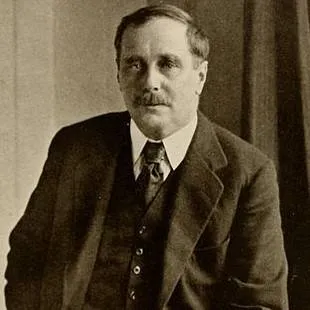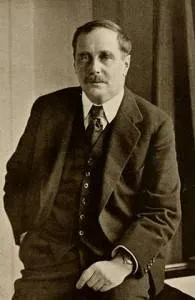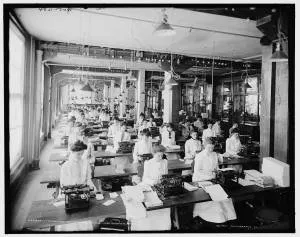
H.G. Wells, Feminist Author
This content contains affiliate links. When you buy through these links, we may earn an affiliate commission.
 Author H.G. Wells (1866–1946) has left an indelible mark on popular culture through science fiction novels such as The Time Machine and The War of the Worlds. But a novel that was especially notorious during his lifetime had nothing to do with the future or with space. Instead, Wells caused a scandal with his feminist coming-of-age novel Ann Veronica.
Wells’s fiction debut was The Time Machine, published in 1895. Other works of science fiction followed, such as The Island of Doctor Moreau (1896), The Invisible Man (1897), and The War of the Worlds (1898). Gradually, Wells abandoned science fiction and instead began writing novels with female protagonists, set among the British lower middle class. Here, Wells brought his political views regarding women’s suffrage, economic independence, and rights to education to the forefront. During the first two decades of the twentieth century, Wells wrote six novels of this kind, the most famous being Ann Veronica, published in 1909.
Ann Veronica is a coming-of-age story about Ann Veronica Stanley, a twenty-two year old woman who wishes to pursue a Bachelor of Science degree in biology and choose her own friends. Because of this, she clashes with her father and leaves home. Determined to make it on her own, Ann Veronica encounters the obstacles that faced women who wished to pursue an independent life during the early twentieth century, e.g. difficulties finding lodging for a single woman and paying tuition fees without an independent income. After serving a prison sentence for participating in a suffragette demonstration, Ann Veronica reconciles with her father and resumes her biology studies. At the biology laboratory, Ann Veronica falls in love with lab assistant Capes. Capes is already married, but is separated from his wife. In spite of his marriage, Ann Veronica declares she wants to spend her life with Capes and the two run away to Switzerland together. The novel ends four years later when Ann Veronica and Capes are married and expecting their first child.
Ann Veronica as the female protagonist is an expression of the New Woman, a feminist ideal that emerged in late nineteenth-century Great Britain and which exerted great influence on the women’s movement around the turn of the twentieth century. A New Woman was educated and had a career. She exercised control over her own personal, social, and economic life, pushing the limits set by male society. Other New Woman literary heroines are Isabel Archer in Henry James’s The Portrait of a Lady (1881) and Mina Harker in Bram Stoker’s Dracula (1897).
Author H.G. Wells (1866–1946) has left an indelible mark on popular culture through science fiction novels such as The Time Machine and The War of the Worlds. But a novel that was especially notorious during his lifetime had nothing to do with the future or with space. Instead, Wells caused a scandal with his feminist coming-of-age novel Ann Veronica.
Wells’s fiction debut was The Time Machine, published in 1895. Other works of science fiction followed, such as The Island of Doctor Moreau (1896), The Invisible Man (1897), and The War of the Worlds (1898). Gradually, Wells abandoned science fiction and instead began writing novels with female protagonists, set among the British lower middle class. Here, Wells brought his political views regarding women’s suffrage, economic independence, and rights to education to the forefront. During the first two decades of the twentieth century, Wells wrote six novels of this kind, the most famous being Ann Veronica, published in 1909.
Ann Veronica is a coming-of-age story about Ann Veronica Stanley, a twenty-two year old woman who wishes to pursue a Bachelor of Science degree in biology and choose her own friends. Because of this, she clashes with her father and leaves home. Determined to make it on her own, Ann Veronica encounters the obstacles that faced women who wished to pursue an independent life during the early twentieth century, e.g. difficulties finding lodging for a single woman and paying tuition fees without an independent income. After serving a prison sentence for participating in a suffragette demonstration, Ann Veronica reconciles with her father and resumes her biology studies. At the biology laboratory, Ann Veronica falls in love with lab assistant Capes. Capes is already married, but is separated from his wife. In spite of his marriage, Ann Veronica declares she wants to spend her life with Capes and the two run away to Switzerland together. The novel ends four years later when Ann Veronica and Capes are married and expecting their first child.
Ann Veronica as the female protagonist is an expression of the New Woman, a feminist ideal that emerged in late nineteenth-century Great Britain and which exerted great influence on the women’s movement around the turn of the twentieth century. A New Woman was educated and had a career. She exercised control over her own personal, social, and economic life, pushing the limits set by male society. Other New Woman literary heroines are Isabel Archer in Henry James’s The Portrait of a Lady (1881) and Mina Harker in Bram Stoker’s Dracula (1897).

Typist was a typical job for a New Woman. Source: Detroit Publishing Company Photograph Collection, Library of Congress.









